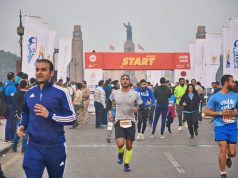By Mariam Sobhi
There are several reasons people begin practicing yoga. Some wish to work on their physical health, others want to reduce stress in their lives, while for others; it’s a desire to deepen their meditation practices. Yin yoga in specific provides physical, mental, emotional and energetic benefits, and for some, helps further their spiritual journey. The benefit depends on your intention. This practice helps the deeper yin tissues: ligaments, joints, deep fascial networks and bones. All of our tissues are important and need to be exercised so that we can achieve optimal health.
Yin yoga is a very slow pace and meditative practice, no muscles are involved with a main focus on applying adequate stress on our deep connective tissues. The aim is to eventually elongate and stretch these tissues or help them become thicker and stronger. Some people initially find this yoga style slow, passive, soft and boring, but they quickly discover that it can be quite challenging due to the long duration of the poses.
There are 3 main elements that any practitioner needs to keep in mind while practicing Yin yoga.
Time: Postures are held for a long time. Between 3-8 minutes for beginners and up to 25 minutes for more advanced practitioners.
Depth: We should go as deep into a pose as our limits allow. The saying, “no pain, no gain” doesn’t apply here, it’s actually forbidden. We should respect our limits and stop there, never stay in pain. Feel the stretch and stay there for the duration intended. Any uncomfortable feeling like pinching, burning or electrical impulses across our body should be avoided; those are a clear message from our body that we are pushing too much.
Steadiness: As soon as you find a comfortable position to stay in, stay still and don’t move. Try to sink in the posture physically, mentally and emotionally.
Sphinx & Seal
This pose tones the spine and people with bulging or herniated disks may find this very therapeutic. In the full Seal pose, the stomach may receive a lovely stretch. It stimulates the kidney and adrenal glands meridian lines through compression. The recommended hold time for Sphinx is 5 minutes and for Seal is 1 minute, and then back to Sphinx.
Straddle
This pose opens the hips, groin, and the back of the thighs, provide a gentle opening to the knees. It also stimulates the ovaries, urinary bladder, liver, kidneys and spleen meridian lines. The recommended hold time is 3-10 minutes.
Swan & Sleeping Swan
This pose provides a vigorous way to open the hip allowing gravity to do the work. It also provides the quadriceps and hip flexors a nice stretch for the side that has the leg back, as well as a strong external rotation of the front hip. The recommended hold time for Swan is 1 to 3 minutes, and then switch to Sleeping position for another 1 to 3 minutes.
Shoelace
This pose is a great hip opener and provides decompression for the lower spine when folding forward. It stimulates the liver, kidneys and gall bladder meridian lines if folding forward. The urinary bladder will be stimulated as well and the stomach compressed, along with hips and lower spine affected.
Butterfly
This pose is a nice way to stretch the lower back without requiring loose hamstrings. If the legs are straighter and the feet further away from the groins, the hamstrings will get more of a stretch. If the feet are in closer to the groins, the adductor muscles get stretched more. Good for the kidneys and prostate gland, so highly recommended for people suffering from urinary problems. Removes any heaviness in the testicles and regulates menstrual cycles, helping ovaries to function properly and eases child birth.





